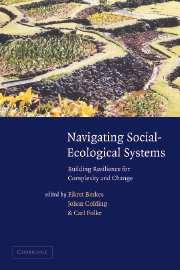Book contents
- Frontmatter
- Contents
- List of contributors
- Preface
- Acknowledgements
- Foreword: The backloop to sustainability
- 1 Introduction
- Part I Perspectives on resilience
- Part II Building resilience in local management systems
- Part III Social-ecological learning and adaptation
- 8 Exploring the role of local ecological knowledge in ecosystem management: three case studies
- 9 Facing the adaptive challenge: practitioners' insights from negotiating resource crises in Minnesota
- 10 Caribou co-management in northern Canada: fostering multiple ways of knowing
- Part IV Cross-scale institutional response to change
- Index
- References
10 - Caribou co-management in northern Canada: fostering multiple ways of knowing
Published online by Cambridge University Press: 13 August 2009
- Frontmatter
- Contents
- List of contributors
- Preface
- Acknowledgements
- Foreword: The backloop to sustainability
- 1 Introduction
- Part I Perspectives on resilience
- Part II Building resilience in local management systems
- Part III Social-ecological learning and adaptation
- 8 Exploring the role of local ecological knowledge in ecosystem management: three case studies
- 9 Facing the adaptive challenge: practitioners' insights from negotiating resource crises in Minnesota
- 10 Caribou co-management in northern Canada: fostering multiple ways of knowing
- Part IV Cross-scale institutional response to change
- Index
- References
Summary
Introduction
The links between social and ecological systems are represented by diverse ways of looking at human–environment relations. The continuing exchange between different ways of knowing may be crucial to integrative thought about social–ecological linkages. For many indigenous societies, the separation of social and ecological systems does not make sense. A ‘human–environment’ divide is especially absent from many arctic and subarctic cultures. How does this fundamental ideological difference play out in resource management systems that incorporate stakeholders both from ‘the West’ (Euro-American) and from indigenous cultures for whom a human–environment or social–ecological divide is a relatively new and foreign concept?
This chapter looks at the differences that exist in the perceptions of indigenous caribou-using communities, caribou managers, and scientists in co-management processes in arctic and subarctic North America. It is contended that these differences represent potentials to expand how we think about human–Rangifer (caribou) systems as much as they represent obstacles to caribou research, monitoring, and management decision-making. The process of negotiating cross-cultural differences in the co-management of caribou herds indicates the potential for the growth of alternative resource management systems capable of accommodating varied ways of knowing and learning.
The question of how humans learn to respect other ways of knowing is represented here as an examination of humility, a respect for diverse realities. There are multiple epistemologies outlining ethical positions of human–environment relations and human perceptions of nature (Folke, Berkes, and Colding, 1998).
- Type
- Chapter
- Information
- Navigating Social-Ecological SystemsBuilding Resilience for Complexity and Change, pp. 241 - 268Publisher: Cambridge University PressPrint publication year: 2002
References
- 3
- Cited by

